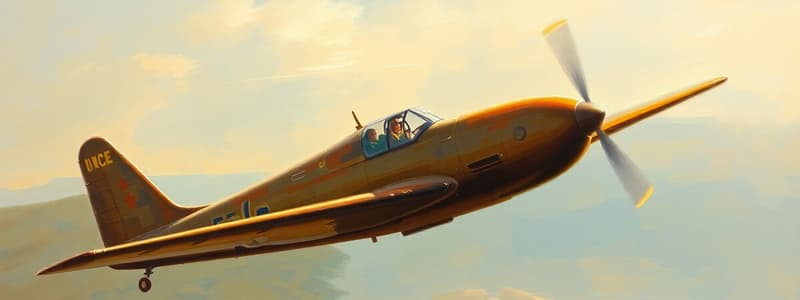Podcast
Questions and Answers
What does the term $q_{ ext{∞}}$ represent in aerodynamics?
What does the term $q_{ ext{∞}}$ represent in aerodynamics?
- Total energy
- Lift force
- Static pressure
- Dynamic pressure (correct)
When calculating true air speed, which factor is NOT included?
When calculating true air speed, which factor is NOT included?
- Indicated air speed
- Altitude of the aircraft
- Weight of the aircraft (correct)
- Density of air
Which ice protection system is mentioned as advanced?
Which ice protection system is mentioned as advanced?
- Basic Anti-ice System
- Standard Frost Control System
- Enhanced Snow Protection System
- 787 Advanced Ice Protection System (correct)
In aerodynamics, what is the difference between indicated air speed and true air speed primarily based on?
In aerodynamics, what is the difference between indicated air speed and true air speed primarily based on?
What effect does icing have on the performance of an aircraft?
What effect does icing have on the performance of an aircraft?
What is the lift per unit span for a wing at a 4° angle of attack, given the parameters?
What is the lift per unit span for a wing at a 4° angle of attack, given the parameters?
What is the chord length of the wing used in the given calculations?
What is the chord length of the wing used in the given calculations?
At zero angle of attack, what was the drag on the wing model mentioned?
At zero angle of attack, what was the drag on the wing model mentioned?
What is the velocity of the flow in the test section as described in the data?
What is the velocity of the flow in the test section as described in the data?
What happens to the angle of attack of the wing to achieve zero lift?
What happens to the angle of attack of the wing to achieve zero lift?
What is the unit area considered for the calculations per unit span?
What is the unit area considered for the calculations per unit span?
From the performance of NACA 2412 airfoil, what can be inferred about its lift performance at specified conditions?
From the performance of NACA 2412 airfoil, what can be inferred about its lift performance at specified conditions?
What defines a drag coefficient in the context of the example provided?
What defines a drag coefficient in the context of the example provided?
What does the inviscid flow airfoil theory primarily predict?
What does the inviscid flow airfoil theory primarily predict?
Which aspect does the inviscid flow airfoil theory NOT account for?
Which aspect does the inviscid flow airfoil theory NOT account for?
What is the relationship of the lift slope with Reynolds number (Re) in inviscid flow theory?
What is the relationship of the lift slope with Reynolds number (Re) in inviscid flow theory?
Which of the following components represents the force parallel to the freestream in the aerodynamic force?
Which of the following components represents the force parallel to the freestream in the aerodynamic force?
What does the axial force represent in aerodynamics?
What does the axial force represent in aerodynamics?
How is the resultant aerodynamic force calculated for an airfoil?
How is the resultant aerodynamic force calculated for an airfoil?
Given a normal force of 100 N and an axial force of 50 N, what is the lift when the angle of attack is 10 degrees?
Given a normal force of 100 N and an axial force of 50 N, what is the lift when the angle of attack is 10 degrees?
What does the angle of attack (α) measure with respect to the airfoil?
What does the angle of attack (α) measure with respect to the airfoil?
What is the formula for calculating the Reynolds number (Re)?
What is the formula for calculating the Reynolds number (Re)?
What parameters are essential for determining the actual magnitude of Lift (L), Drag (D), and Moment (M)?
What parameters are essential for determining the actual magnitude of Lift (L), Drag (D), and Moment (M)?
In dimensional analysis, what is the dimension of Force?
In dimensional analysis, what is the dimension of Force?
What unit is used for measuring viscosity in the SI system?
What unit is used for measuring viscosity in the SI system?
Given a chord length of 1.3 m and a flow velocity of 50 m/s, which factor does NOT impact the Reynolds number for this scenario?
Given a chord length of 1.3 m and a flow velocity of 50 m/s, which factor does NOT impact the Reynolds number for this scenario?
What is the relationship of dimensional analysis in aerodynamic studies?
What is the relationship of dimensional analysis in aerodynamic studies?
In British units, how is density expressed?
In British units, how is density expressed?
Which of the following is NOT a parameter for dimensional analysis in aerodynamics?
Which of the following is NOT a parameter for dimensional analysis in aerodynamics?
Flashcards
Inviscid Flow Airfoil Theory
Inviscid Flow Airfoil Theory
The theory predicts the lift slope (a0) and zero-lift angle of attack (a0). This theory simplifies the flow by assuming the fluid is inviscid and incompressible.
Limitations of Inviscid Flow Theory
Limitations of Inviscid Flow Theory
The maximum lift coefficient (CLmax) and airfoil drag cannot be predicted by this theory.
Lift Slope (a0)
Lift Slope (a0)
The lift slope of an airfoil, denoted as a0, is a measure of how much lift is produced for a given change in angle of attack.
Zero-Lift Angle of Attack (a0)
Zero-Lift Angle of Attack (a0)
Signup and view all the flashcards
Resultant Aerodynamic Force
Resultant Aerodynamic Force
Signup and view all the flashcards
Normal Force (N)
Normal Force (N)
Signup and view all the flashcards
Axial Force (A)
Axial Force (A)
Signup and view all the flashcards
Angle of Attack (a)
Angle of Attack (a)
Signup and view all the flashcards
Lift Force
Lift Force
Signup and view all the flashcards
Drag Force
Drag Force
Signup and view all the flashcards
Lift Coefficient (CL)
Lift Coefficient (CL)
Signup and view all the flashcards
Drag Coefficient (CD)
Drag Coefficient (CD)
Signup and view all the flashcards
Lift-to-Drag Ratio (L/D)
Lift-to-Drag Ratio (L/D)
Signup and view all the flashcards
Wing Area (S)
Wing Area (S)
Signup and view all the flashcards
Chord Length (c)
Chord Length (c)
Signup and view all the flashcards
Reynolds Number (Re)
Reynolds Number (Re)
Signup and view all the flashcards
Chord (c)
Chord (c)
Signup and view all the flashcards
Diameter (d)
Diameter (d)
Signup and view all the flashcards
Length (l)
Length (l)
Signup and view all the flashcards
Dimensional Analysis
Dimensional Analysis
Signup and view all the flashcards
Lift (L)
Lift (L)
Signup and view all the flashcards
Drag (D)
Drag (D)
Signup and view all the flashcards
Dynamic Pressure
Dynamic Pressure
Signup and view all the flashcards
True Air Speed (TAS)
True Air Speed (TAS)
Signup and view all the flashcards
Ground Speed
Ground Speed
Signup and view all the flashcards
Indicated Air Speed (IAS)
Indicated Air Speed (IAS)
Signup and view all the flashcards
Airspeed Correction
Airspeed Correction
Signup and view all the flashcards
Study Notes
Aerodynamics - Part 2
- Aerodynamics deals primarily with airfoil theory for inviscid, incompressible flow.
- Inviscid flow airfoil theory cannot predict maximum lift coefficient (Clmax) or airfoil drag.
- Lift slope (α₀) and zero-lift angle of attack (CL=0) can be predicted.
- Clmax depends on Reynolds number (Re).
- Lift slope is not influenced by Re except at large α.
- The Cm is insensitive to Re except at large α.
- Cm is approximately at c/4 point.
- Clmax is approximately 1.7.
- Zero-lift angle is approximately -2.1°.
- Stall angle is approximately 16°.
- The resultant aerodynamic force (R) is the integration of pressure (p) and shear stress (τ) distribution over the airfoil.
- Chord (c) is the linear distance from leading edge (LE) to trailing edge (TE) of the airfoil.
- Freestream velocity (V∞) is the flow velocity far ahead of the airfoil.
Airfoil Characteristics
- This chapter deals primarily with airfoil theory for an inviscid, incompressible flow.
- This theory can predict the lift slope (a₀) and zero-lift angle of attack (CL=0).
- This theory cannot predict maximum lift coefficient (Clmax) and airfoil drag.
NACA 2412 Airfoil
- The lift slope is not influenced by Reynolds number (Re) except at high angles of attack.
- The maximum lift coefficient (Clmax) is dependent on Re.
- Experimental data for different Reynolds numbers (Re) are provided for Clmax.
- The moment coefficient (Cm_c/4) is approximately at c/4 point.
Experimental Results
- The maximum lift coefficient (Clmax) is governed by viscous effects.
- Clmax depends on Re.
The Resultant Aerodynamic Force
- The total force acting on an airfoil is the integration of pressure and shear stress distribution.
- The linear distance from leading edge to trailing edge is the chord (c).
- The flow velocity far ahead of the body is freestream velocity (V∞).
Normal Force & Axial Force
- Normal force (N) is the component of the resultant force (R) perpendicular to the chord line.
- Axial force (A) is the component of the resultant force (R) parallel to the chord line.
Angle of Attack
- Angle of attack (α) is the angle between the chord line (c) and the freestream velocity (V∞).
- Angle of attack is also the angle between lift (L) and the resultant force(R).
- Angle of attack is also the angle between drag (D) and the resultant force (R).
Lift & Drag
- Lift (L) is the component of the resultant force (R) perpendicular to the freestream (V∞).
- Drag (D) is the component of the resultant force (R) parallel to the freestream (V∞).
- Lift relationship: L = N cos α - A sin α
- Drag relationship: D = N sin α + A cos α
Reynolds Number (Re)
- Re represents the ratio of inertial forces to viscous forces.
- Re = ρ∞V∞c/μ
- Where:
- ρ∞ is freestream air density.
- V∞ is freestream velocity.
- c is the chord.
- μ is the dynamic viscosity.
Dimensional Analysis
- The magnitude of lift (L), drag (D), and moment (M) depends on various parameters like velocity, density, angle of attack.
Definitions
- A knot is a nautical mile per hour.
Aircraft Speeds
- Indicated airspeed (IAS) is the airspeed measured by an airspeed indicator.
- Ground speed (GS) is the speed of the aircraft over the ground.
- True airspeed (TAS) is the speed of the aircraft relative to the air mass.
- Dynamic pressure is 1/2 * ρ * V^2.
- Airspeed indicators are calibrated for standard conditions (sea level density)
Icing Effects
- Icing can increase drag and decrease lift.
- It can cause destructive vibrations, hamper true instrument readings, unbalance, or freeze control surfaces, cause radio jamming and affect engine performance.
- Icing increases stalling speed.
Studying That Suits You
Use AI to generate personalized quizzes and flashcards to suit your learning preferences.



